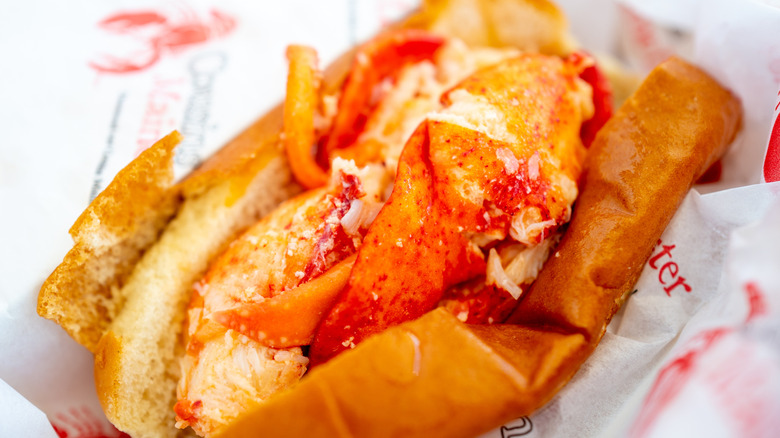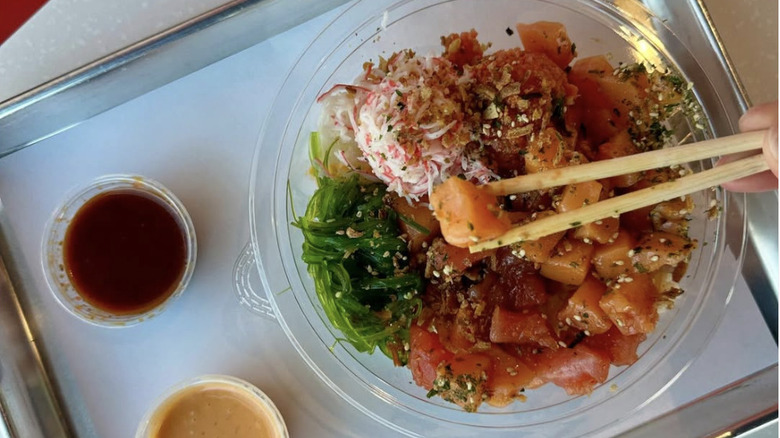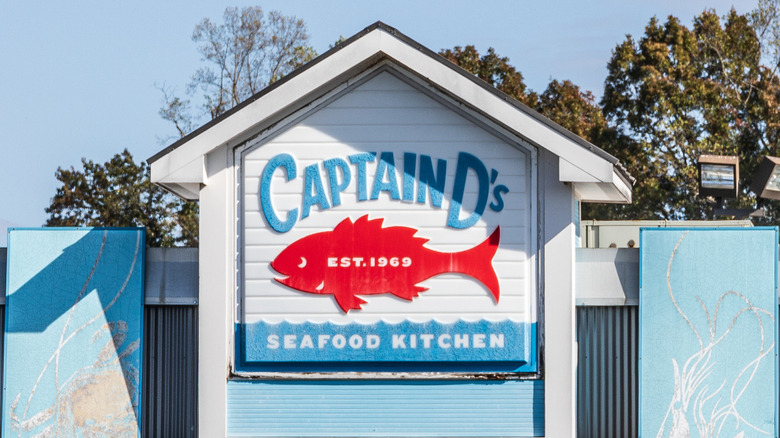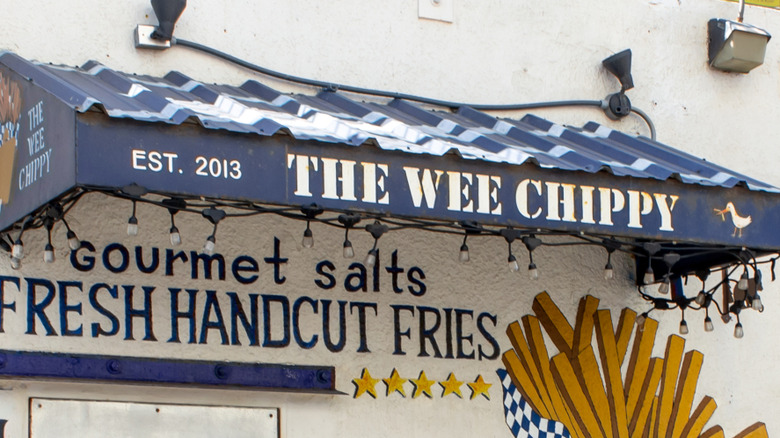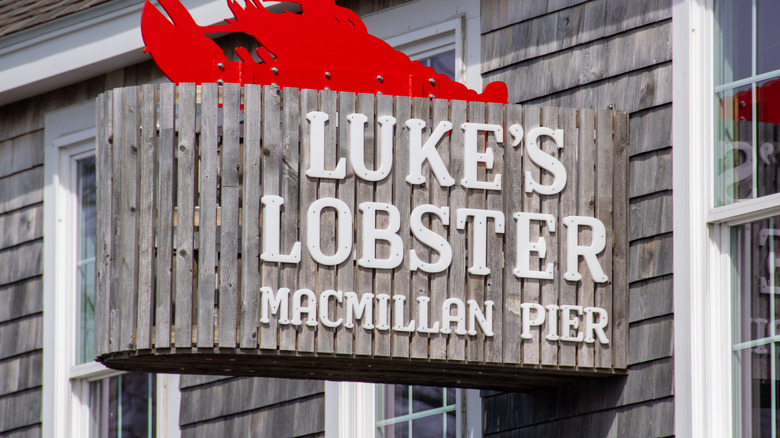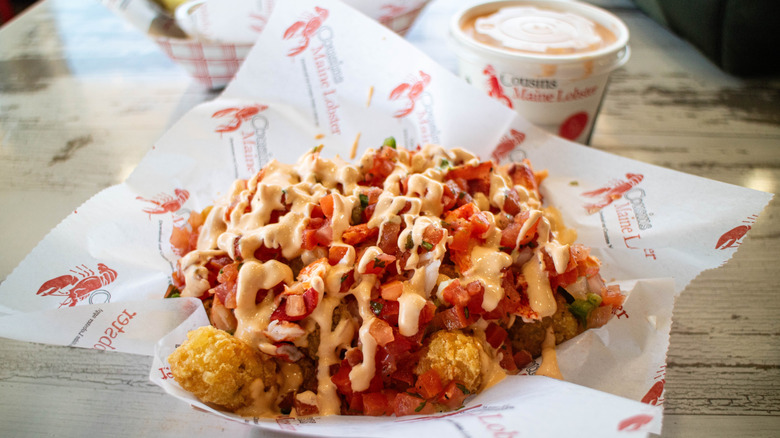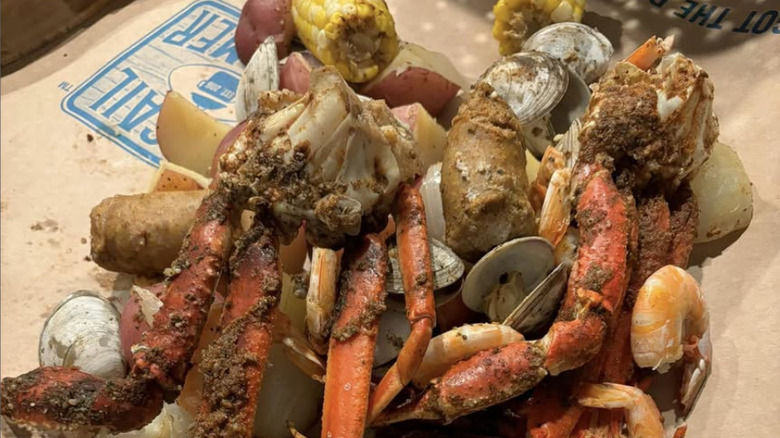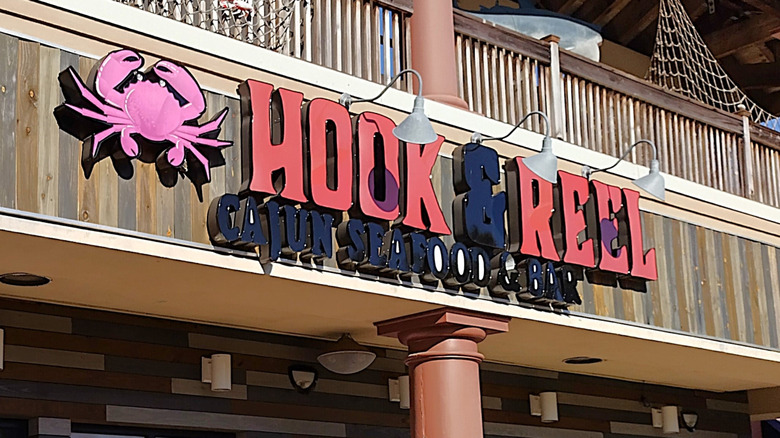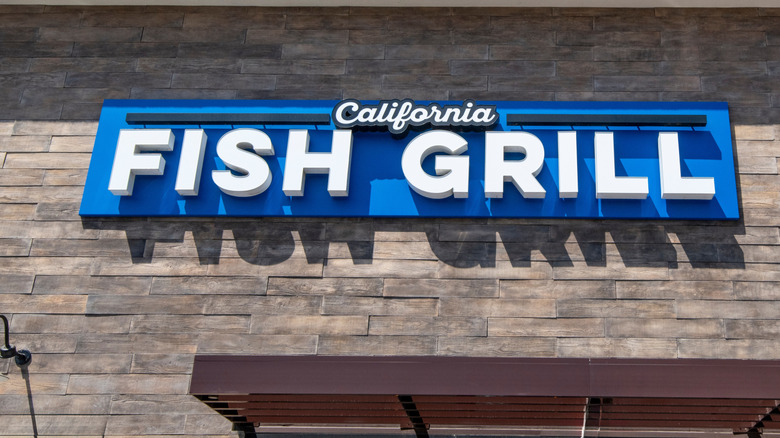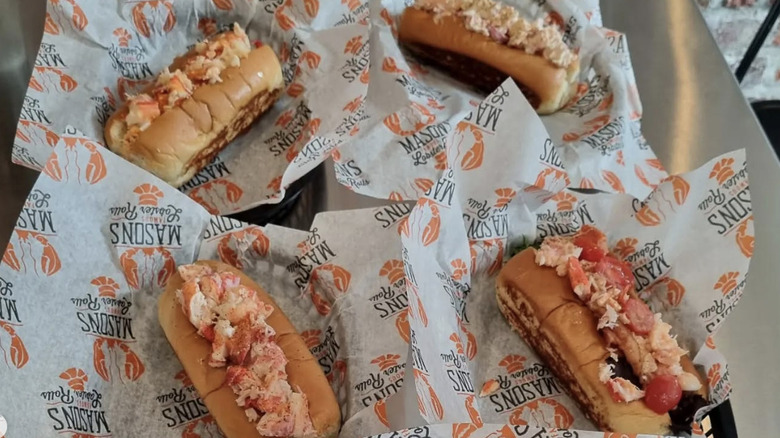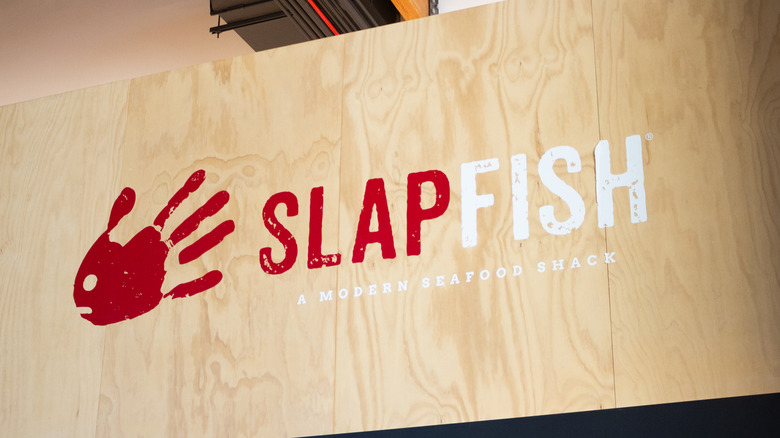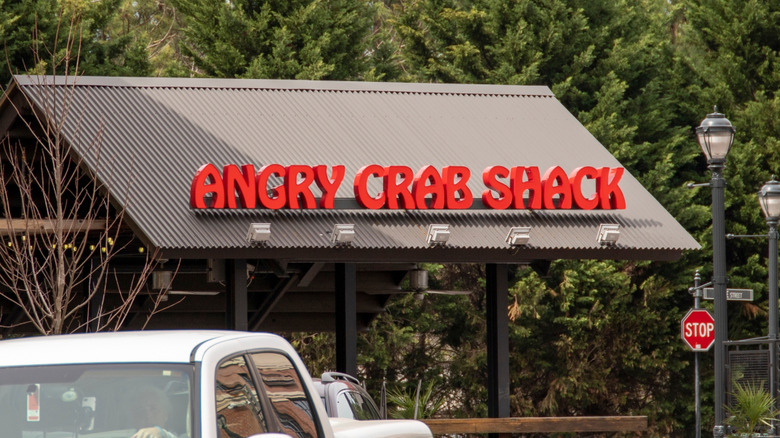The Fastest Growing Seafood Chains In The US
Whether it's easy-in, easy-out fast food chains, or slightly more upscale casual dining venues, the kind of food that generally dominates the American restaurant scene is stuff that comes from the land. Burgers, steaks, fried chicken, potatoes, and salads seem to be what most eateries want to serve. Less prominent, historically speaking, are seafood restaurants. Perhaps because the desire to consume swimming fish and shellfish alike is so polarizing from person to person, and because tastes vary greatly across regions of the United States, very few seafood chains have ever enjoyed a national presence like that of the burger and chicken places.
That all seems to be changing, and quickly. As the American palate and mainstream restaurants both expand to include a larger variety of foods, the demand for seafood served fried, raw, or as part of sandwiches or specific culinary traditions from around the world has grown. More and more new seafood-themed chains are popping up around the U.S., while ones that have been around for years are aggressively moving into new markets. Here then are the seafood restaurants getting bigger, going regional, and taking their operations to the entirety of the country — the fish establishments most on the rise.
Koibito Poke
Up until just a few years ago, poke bowls were rarely found in the mainland U.S., or outside of its origin point and popularity nexus of Hawaii. A fast food and grocery store counter staple, the dish is made from marinated high-grade tuna or other raw fish cut to the proper poke thickness and served atop rice with any number of toppings, generally ingredients associated with sushi rolls. A healthier and fresher-seeming alternative to the fried fish that populates the menus of most fish restaurants in the contiguous United States, poke is the foundation of a growing fast food subset.
One of the biggest players taking poke bowls from Hawaiian meal and mainland fad into a permanent part of the mainstream American diet is Koibito Poke. Former star baseball pitcher Todd Stottlemyre helped grow the company (whose name means "sweetheart") into a viable chain restaurant after the first location opened in Scottsdale, Arizona in 2018. Utilizing the service approach honed by Subway and Chipotle, customers go through a line where employees customize their bowls with various options for bases, fishes, toppings, and sauces. Five years later, Koibito was on the verge of opening two dozen outlets. It also made a pact with True Capital Partners to open at least 300 poke shops in eight states by the end of 2027.
Captain D's
Captain D's once sold much more than seafood: It started out as Mr. D's Seafood and Hamburgers in 1969 in Donelson, Tennessee. One of the first fast food and low-cost seafood restaurants in the country, Mr. D's expanded to 15 locations by 1974, when it dropped the burgers and became Captain D's, selling a menu built around fried fish and fried shrimp. About 35 years later, Captain D's was a 600-unit chain, with almost all of its restaurants located in the South.
Following some setbacks in the 2000s, including the bankruptcy of its then-biggest franchisee, Serve Holdings, so many Captain D's restaurants closed that by 2024 it operated just over 500 locations. And yet, Captain D's is now ready to compete with other fast food fish places, some of which it predates and inspired. The company announced a calculated expansion plan in February 2025. In what constitutes its biggest attempt ever at moving outside of the southeastern U.S., Captain D's will open restaurants in Maryland for the first time, with five outlets planned for the Baltimore area alone. There will be more Captain D's in Texas, too, with three spots planned for the San Antonio area. All the while, the fish restaurant will wade into international waters, planning to open 20 restaurants in the U.K.
The Wee Chippy
Fish and chips — a big piece of fried whitefish and a pile of french fries — has been the quintessential fast food in the U.K. since the late 1800s. In 2013, Joe Gorrie, a native of Scotland, opened a small restaurant in Venice Beach, California, called The Wee Chippy, and at first, the establishment sold only fries. In 2015 The Wee Chippy moved up from humble chippy into a full-fledged takeaway when Gorrie added golden-brown, battered fish to the menu. Vegan and vegetarian fish substitutes arrived two years after that. "We are filling an opening in the market. Fish and chips is a universally loved dish, yet in the U.S., there is no known successful fish-and-chips brand," Gorrie told Seafood Source.
The Wee Chippy built up such a following filling that niche that in 2023, Gorrie signed a deal to greatly expand his restaurant. That year, he teamed up with The Tastebuds Group to open a total of 30 Wee Chippy shops around the country, with an initial focus on markets like Colorado, Tennessee, Florida, and Texas.
One thing in the restaurant's favor: It's an easily scalable business due to its simplicity and relative low cost. A Wee Chippy doesn't need much more than a few hundred square feet to operate, enough room to accommodate two fryers, a fridge, and a freezer. The franchise fee is just $132,000, or about 10% of what it costs to start up a McDonald's.
Luke's Lobster
Where does the lobster roll actually come from? Right now, more and more Americans are getting them from Luke's Lobster. The "Luke" in Luke's Lobster is a real person. After an unfulfilling job on Wall Street, Luke Holden looked to his childhood in Maine, where lobster fishing is a major industry and lobster rolls are ubiquitous. In 2009, he opened the initial Luke's Lobster in New York City's East Village.
As of 2025, Holden has pretty much fulfilled his dream of bringing lobster rolls to the world at large, as there are 28 Luke's Lobster "shacks" serving up the sandwiches of shellfish chunks, mayonnaise, and spices in the United States (23 on the East Coast, five on the West Coast) and an additional nine units in Asia. In 2018, Luke's Lobster attained B Corp status, meaning its certifiably socially and environmentally above-board, focusing on using sustainable seafood sources.
In 2025, Whole Foods Market and Relentless Consumer Partners injected huge amounts of capital into Luke's Lobster in order to grow the company even more, particularly in the area of packaged and grocery items bearing the company's branding, such as frozen lobster meat and tails, and pasta entrees. The new money will then go into opening even more restaurants throughout the United States.
Shuckin' Shack
Should we really be eating raw oysters? That's a complicated question, but they're certainly an enjoyable treat when visiting or living in coastal areas where oysters can be harvested. Shuckin' Shack Oyster Bar is one such place where seafood fans can enjoy oysters, one of the best affordable and delicious-tasting seafoods. The first location opened in Carolina Beach, North Carolina, in 2007, and after a second spot did well in 2012, franchising began in 2014. Just over 10 years later, there are 19 Shuckin' Shacks open for business, serving a vast menu of shrimp, calamari, crab, ahi, and shrimp, as well as a raw bar in which oysters are the main attraction.
Most of the Shuckin' Shacks opened in coastal areas of North Carolina, and subsequent restaurants appeared in Atlantic Ocean-bordering states like Georgia and Maryland. The growing chain is taking beach food into the interior, too, with a spot in Illinois.
Cousins Maine Lobster
Back in 2012, cousins Sabin Lomac and Jim Tselikis went into business together, buying a food truck to sell lobster rolls in Los Angeles, where the Maine-based sandwich was relatively obscure. Seeking to make the business grow as quickly as possible, the duo pleaded its case on ABC's "Shark Tank," where they negotiated an infusion of $55,000 in exchange for a 15% share for investor Barbara Corcoran. Lomac and Tselikis made the most of that cash, launching a network of Cousins Maine Lobster food trucks that operate out of cities across the country. By the end of 2016, 20 Cousins Maine Lobster trucks were selling a variety of lobster rolls, lobster tacos, lobster tots, lobster quesadillas, and lobster bisque.
The chain's growth since its initial moves has been nothing less than explosive. There are now 63 food trucks in 28 states, along with three traditional, freestanding restaurants in San Francisco, New Jersey, and Florida, and at least three more trucks scheduled to open soon.
Topsail Steamer
The most important part of a seafood boil is timing the addition to the water of each component, so that none of the various fishes and starchy vegetables wind up overcooked and ruined. That's a responsibility that an innovative seafood takeout chain aims to share with its customers. Visitors to Topsail Steamer cannot eat on site, because the restaurant doesn't cook for diners, nor does it have anywhere to sit. The restaurant instead sells steam pot kits that provide everything consumers need to have a seafood boil at home, including precooked snow crab, peel-and-eat-shrimp, scallops, corn, andouille sausage, potatoes, and proprietary seasoning blends. Customers order and pick up their steam pot (or "Bay Bucket," in Topsail Steamer parlance), take it home, add water, and feast.
After starting with one location in 2017 – on Topsail Island, North Carolina – Topsail Steamer is growing, with 10 total takeout spots operational by 2025. It partnered with venture firm Elite Franchise Capital and franchising legal firm Spadea Lignana to start up 40 more outlets in the next few years, which won't be as daunting or expensive a task as it would be if Topsail Steamer were a full-service restaurant.
Hook & Reel
Cajun cuisine – spicy, seafood-heavy, and an evolution of French, Acadian, and native Louisiana styles — hasn't historically been heavily represented in the casual restaurant scene. But Hook & Reel is here to change that. The first restaurant in the burgeoning chain opened in Maryland in 2013, and by 2020, owners had franchised the concept to the tune of 28 locations offering Cajun and Creole seafood with plans to open as many as 50 locations within a year's time, including three just in Brooklyn.
Even with the serious and devastating interruption in the restaurant economy caused by the COVID-19 virus and widespread dining room shutdowns, Hook & Reel has continued to bolster its bottom line. Popular for its two-person, bargain-priced meals of premium seafood like Dungeness crab, clams, and crab legs, in 2022 it was the quickest-growing seafood restaurant chain in the U.S. with revenues of $80.2 million, doubling what it brought in the previous year. As of 2025, 66 Hook & Reel restaurants operate in 22 states, none of which have an especially rich tradition of Cajun cooking.
California Fish Grill
For most of its history, California Fish Grill Casual Kitchen was a low-key regional favorite. It was a place where denizens of the West Coast, who already have a plethora of seafood restaurants from which to frequent, could go for fresh and certified sustainable seafood, cooked and prepared with relatively healthy methods at a competitive for fast food price. After operating out of Gardena, California, since 1998, only eight new California Fish Grill spots had opened by 2014, when Bob Holden became the chain's new CEO. Following a period of pointed and sustained growth, there were 29 California Fish Grill restaurants over the following five years, including ones in brand new markets like Phoenix and Las Vegas.
California Fish Grill offers a menu that's familiar but different, with bowls, platters, combos, and sandwiches that resemble those found at other chain restaurants, but with fish the protein instead of chicken or beef. Some of its most popular offerings include shrimp tacos with rice and beans, ahi poke with tortilla chips, battered fish and chips, and Atlantic salmon with tomato salad. That novelty helped the company grow: By the end of 2024, California Fish Grill was a chain of 47 restaurants, all in the far western U.S., but with three new locales on the East Coast set to open by the end of 2025.
Mason's Famous Lobster Rolls
Hailing from Maine specifically and the New England area in general, the lobster roll is making inroads into the rest of the United States by way of chains who have made the luxurious sandwich, a high-low combo of fancy shellfish and common condiments, the focal point of its menu. Among those champions of the lobster roll is Mason's Famous Lobster Rolls. After working as a buyer in the seafood industry for two decades, Dan Beck became so fascinated with the lobster culture of Maine, and accurately predicting the rise of the lobster roll, that in 2014, he started his own restaurant in Annapolis, Maryland.
The establishment's traditional and classic take on the sandwich — which were a relative bargain in the $15 range — quickly proved popular with diners. When a franchising consultant came calling in 2016, Beck agreed to license out his restaurant format and recipes. In under a decade, Mason's Famous Lobster Rolls was a 30-unit company, with locations situated primarily up and down the Eastern Seaboard, but with a few satellites in relatively far-flung spots like Minnesota, Colorado, and Arizona. By 2025, Mason's was making sandwiches in 40 restaurants altogether. Plans remain in place to get to 50 eateries within a couple of years, as well expanding across Europe.
Slapfish
In 2011, chef Andrew Gruel opened the first chapter in what would be Slapfish, leasing a food truck from which he sold fish sandwiches, fish tacos, and lobster rolls, the latter of which was made with shellfish shipped in from Maine to his Los Angeles area home-base. Three months later, Gruel operated three food trucks. By 2012, he was looking at moving into a non-moving restaurant space, but had a tough time attracting investors because his concept of a low-key fried fish and lobster roll spot was so novel. "At the time there was a huge gap in the market. The only option you had for seafood was fine dining or cheap Long John Silver's style," Gruel told Forbes. "In the fast casual realm, a step up from fast food and a step down from casual dining, there was nothing for seafood."
Slapfish sold a variety of seafood dishes, made with product caught by area fisheries and international sources that have been certified as sustainable. By 2016, six locations throughout Southern California were operational. After allowing the restaurant to be franchised, more Slapfish eateries opened, with a goal of opening 75 locations by 2020, including launching the brand in the U.K. Many have since closed, but the brand has succeeded with restaurants in New Mexico and Indiana while maintaining one highly visible California location at the Los Angeles International Airport. Gruel has since left the company to put his attentions on another seafood restaurant called Calico Fish House.
Angry Crab Shack
Spreading the fun of the East Coast phenomenon of seafood boils around the United States, Angry Crab Shack has been in existence only since 2013, carving out a new niche inside of what's already the niche market of seafood and finding a lot of success in the process. Co-founded by former NFL lineman Ron Lou, Angry Crab Shack opened 18 locations in four states. This was mostly through the work of franchisees, such as Lincoln Kennedy, another NFL veteran who owns two of the rising chain's locations.
On the national front, Angry Crab Shack doesn't have a lot of competition that sells what it sells. The "angry" in the name hints at the fiery heat found throughout its menu, which takes cues from Asian, Cajun, and Creole culinary histories. There's a lot of spice on the menu, particularly in the crawfish, shrimp, crab, and mussel boils, with seasoning added to the customer's preference on a scale from 0 (Me No Likey Spice) up to 5 (Scorching Scorpion) and 6 (Ridiculously Hot). Fans can't get enough, as there are 24 Angry Crab Shacks running in five states, plus another two in England. The company plans to open its 100th restaurant by 2030.
